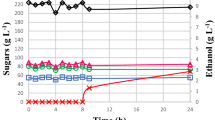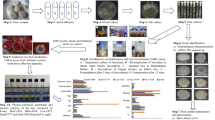Abstract
This work evaluated the effect of the cowpea (Vigna unguiculata L. Walp) extract concentration on mead production. Fermentations were carried out in 500-mL Erlenmeyer flasks containing 250 mL of honey wort (30 °Brix), supplemented with 1 g L−1 of ammonium sulfate and 0.1 g L−1 of magnesium chloride and the cowpea extract (5 and 30 g L−1), inoculated with 106 cells mL−1, and incubated at 30 °C for 240 h. Higher cell growth ((cells mL−1): 11.1 × 107, 11.3 × 107, and 19.6 × 107; substrate consumption (%): 86.0, 90.0, and 85.0) and ethanol production ((v v−1 %): 15.0, 15.5, and 14.1) for yeasts Safbrew T-58, Premier Blanc, and Premier Cuvée, respectively, were obtained with 30 g L−1 of bean extract. S. bayanus Premier Blanc had the best metabolic activity with lowest glycerol production (8.5 g L−1) and highest ethanol volumetric yields (0.51–1.52 h−1) after 48 h of fermentation.



Similar content being viewed by others
References
Campos, G., Della-Modesta, R. C., Silva, T. J. P., Baptista, K. E., Gomides, M. F., & Godoy, R. L. (2003). Classificação do mel em floral ou mel de melato. Ciências e Tecnologia de Alimentos, 23, 1–5.
Finola, M. S., Lasagno, M. C., & Marioli, J. M. (2007). Microbiological and chemical characterization of honeys from central Argentina. Food Chemistry, 100, 1649–1653.
Won, S. R., Lee, D. C., Ko, S. H., Kim, J. W., & Rhee, H. I. (2008). Honey major protein characterization and its application to adulteration detection. Food Research International, 41, 952–956.
Gomes, T., Barradas, C., Dias, T., Verdial, J., Morais, J. S., Ramalhosa, E., & Estevinho, L. M. (2013). Optimization of mead production using response surface methodology. Food and Chemical Toxicology, 59, 680–686.
Pereira, A. P., Mendes-Ferreira, A., Oliveira, J. M., Estevinho, L. M., & Mendes-Faia, A. (2013). A high-cell-density fermentation of Saccharomyces cerevisiae for the optimization of mead production. Food Microbiology, 33(1), 114–123.
Pereira, A. P., Dias, T., Andrade, J., Ramalhosa, E., & Estevinho, L. M. (2009). Mead production: Selection and characterization assays of Saccharomyces cerevisiae strains. Food and Chemical Toxicology, 47(8), 2057–2063.
Navrátil, M., Sturdik, E., & Gemeiner, P. (2001). Batch and continuous mead production with pectate immobilized, ethanol-tolerant yeast. Biotechnology Letters, 23, 977–982.
Iglesias, A., Pascoal, A., Choupina, A. B., Carvalho, C. A., Féas, X., & Estevinho, L. M. (2014). Developments in the fermentation process and quality improvement strategies for mead production. Molecules, 19(8), 12577–12590.
Kempka, A. P., & Mantovani, G. Z. (2013). Produção de hidromel utilizando méis de diferentes qualidades. Revista Brasileira de Produtos Agroindustriais, 15, 273–281.
Roldán, A., Van Muiswinkel, G. C. J., Lasanta, C., Palacios, V., & Caro, I. (2011). Influence of pollen addition on mead elaboration: Physicochemical and sensory characteristics. Food Chemistry, 126, 574–582.
Mendes-Ferreira, A., Cosme, F., Barbosa, C., Falco, V., Inês, A., & Mendes-Faia, A. (2010). Optimization of honey must preparation and alcoholic fermentation by Saccharomyces cerevisiae for mead production. International Journal of Food Microbiology, 144(1), 193–198.
Pereira, A. P., Mendes-Ferreira, A., Estevinho, L. M., & Mendes-Faia, A. (2015). Improvement of mead fermentation by honey-must supplementation. Journal of the Institute of Brewing, 121, 405.
Anunciação, A. S., Martins, B. J. A., Amorim, T. S., Carvalho, G. B. M., & Martinez, E. A. (2017). Polpa de tamarindo (Tamarindus indica L.) na produção de hidromel. Revista Brasileira de Agrotecnologia, 7, 441–445.
Mascarenhas, A. M. O., Amorim, T. S., Anunciação, A. S., Albinati, F. L., & Martinez, E. A. (2017). Produção de hidromel: efeito da concentração da polpa de abacaxi (Ananas mill). Revista Brasileira de Agrotecnologia, 7, 436–440.
Amorim, T. S., Lopes, S. B., Bispo, J. A. C., Bonafe, C. F. S., Carvalho, G. B. M., & Martínez, E. A. (2018). Influence of acerola pulp concentration on mead production by Saccharomyces cerevisiae AWRI 796. LWT- Food Science and Technology, 97, 561–569.
Oliveira, O. M. S., Silva, J. F., Gonçalves, J. R. P., & Klehm, C. S. (2010). Weed coexistence with cowpea cultivars in the Amazonas floodplain. Planta Daninha, 28, 523–530.
Neves, V. A., Pereira, D. D., Shoshima, A. H. R., & Tavano, O. L. (2003). Características da solubilidade proteica e isolamento da globulina principal de caupí (Vigna unguiculata (L.) Walp.) cultivar BR 14-mulato. Alimentos e Nutrição, 14, 47–55.
Frota, K. M. G., Soares, R. A. M., & Arêas, J. A. G. (2008). Composição química do feijão caupi (Vigna unguiculata L. Walp), cultivar BRS-Milênio. Ciência e Tecnologia de Alimentos, 28, 470–476.
Iqbal, A., Khalil, I. A., Ateeq, N., & Khan, M. S. (2006). Nutritional quality of important food legumes. Food Chemistry, 97, 331–335.
Frota, K. M. G., Morgano, M. A., Silva, M. G., Araújo, M. A. M., & Moreira-Araújo, R. S. R. (2010). Utilização da farinha de feijão-caupi (Vigna unguiculata L. Walp) na elaboração de produtos de panificação. Ciência e Tecnologia de Alimentos, 30, 44–50.
Brito, E. S. (2008). Feijão Caupi. Fortaleza: Embrapa Agroindústria Tropical.
Martinez, A. M., Vivas, G. J., & Quicazan, M. C. (2016). Evaluation of alcoholic fermentation during the production of mead using immobilized cells in kappa-carrageenan. Chemical Engineering Transactions, 49, 19–24.
Le Duy, A., & Zajic, J. E. A. (1973). Geometrical approach for differentiation of an experimental function at a point: Applied to growth and product formation. Biotechnology and Bioengineering, 15, 805–815.
Gupta, P., Singh, R., Malhotra, S., Boora, K. S., & Singal, H. R. (2014). Cowpea [Vigna unguiculata (L.) Walp.] seed proteins: Heterogeneity in total proteins and protein fractions. Legume Research, 37, 62–67.
Balogu, T. V., & Towobola, O. (2017). Production and quality analysis of wine from honey and coconut milk blend using Saccharomyces cerevisiae. Fermentation, 3, 1–9.
Lima, U. A., Basso, L. C., & Amorim, H. V. (2001). Biotecnologia Industrial: Processos Fermentativos e Enzimáticos. São Paulo: Blücher.
Schmidell, W., Lima, A. U., Aquarone, E., & Borzani, W. (2001). Biotecnologia Industrial. São Paulo: Blücher.
Ilha, E. C., Bertoldi, F. C., Reis, V. D. A., & Sant’anna, E. (2008). Rendimento e Eficiência da Fermentação Alcoólica na Produção de Hidromel. Corumbá: Embrapa Pantanal.
Gomes, T., Dias, T., Cadavez, V., Verdial, J., Morais, J. S., Ramalhosa, E., & Estevinho, L. M. (2015). Influence of sweetness and ethanol content on mead acceptability. Polish Journal of Food and Nutrition Sciences, 65, 137–142.
Czabaj, S., Kawa-Rygielska, J., Kucharska, A. Z., & Kliks, J. (2017). Effects of mead wort heat treatment on the mead fermentation process and antioxidant activity. Molecules, 22, 803.
Varela, C., Pizarro, F., & Agosin, E. (2004). Biomass content governs fermentation rate in nitrogen-deficient wine musts. Applied and Environmental Microbiology, 70(6), 3392–3400.
Ukpabi, U. J. (2006). Quality evaluation of meads produced with cassava (Manihot esculenta) floral honey under farm conditions in Nigeria. Tropical and Subtropical Agroecosystems, 6, 37–41.
Scanes, K. T., Hohmann, S., & Prior, B. A. (1998). Glycerol production by the yeast Saccharomyces cerevisiae and its relevance to wine: A review. South African Journal for Enology Viticulture, 19, 17–23.
Hernandez, C. Y., Serrato, J. C., & Quicazan, M. C. (2015). Evaluation of physicochemical and sensory aspects of mead, produced by different nitrogen sources and commercial yeast. Chemical Engineering Transactions, 43, 1–6.
Qureshi, N., & Tamhane, D. V. (1987). Production of mead by immobilized cells of Hansenula anomala. Applied Microbiology and Biotechnology, 27, 27–30.
Barbosa, C., Lage, P., Vilela, A., Mendes-Faia, A., & Mendes-Ferreira, A. (2014). Phenotypic and metabolic traits of commercial Saccharomyces cerevisiae yeasts. AMB Express, 4, 39.
Acknowledgments
This work was supported by Coordenação de Aperfeiçoamento de Pessoal de Nível Superior – Brazil (CAPES), Financial Code – 001, and Fundação de Amparo à Pesquisa do Estado de Bahia (FAPESB), Brazil. We thank the Graduate Program in Biotechnology (PPGBiotec) of the State University of Feira de Santana (UEFS).
Author information
Authors and Affiliations
Corresponding author
Ethics declarations
Conflict of Interest
The authors declare that they have no conflict of interest.
Additional information
Publisher’s Note
Springer Nature remains neutral with regard to jurisdictional claims in published maps and institutional affiliations.
The presenting author of this manuscript in journal Applied Biochemistry and Biotechnology is Geiza Suzart Araújo.
Rights and permissions
About this article
Cite this article
Araújo, G.S., Gutiérrez, M.P., Sampaio, K.F. et al. Mead Production by Saccharomyces cerevisiae Safbrew T-58 and Saccharomyces bayanus (Premier Blanc and Premier Cuvée): Effect of Cowpea (Vigna unguiculata L. Walp) Extract Concentration. Appl Biochem Biotechnol 191, 212–225 (2020). https://doi.org/10.1007/s12010-020-03267-0
Received:
Accepted:
Published:
Issue Date:
DOI: https://doi.org/10.1007/s12010-020-03267-0




